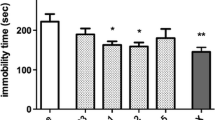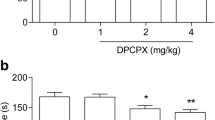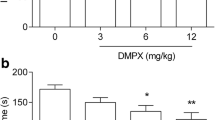Abstract
Introduction
Smoking rates among depressed individuals is higher than among healthy subjects, and nicotine alleviates depressive symptoms. Nicotine increases serotonergic and noradrenergic neuronal activity and facilitates serotonin and noradrenaline release. In mice, acute nicotine administration enhances the activity of antidepressants in the mouse forced swim (mFST) and tail suspension tests. Here, we investigated if this action of nicotine is also reflected in a chronic treatment regimen.
Materials and methods
After chronic treatment with nicotine in the drinking water, mice were challenged with nicotine, duloxetine, citalopram, and reboxetine in the mFST. Additionally, 8-OH-DPAT- and clonidine-induced hypothermia was tested in vehicle- and nicotine-pretreated mice, as a measure of 5-HT1A and α2-adrenoceptor function, respectively. Finally, the effects on the brain expression levels of high- and low-affinity nicotinic acetylcholine receptors (nAChRs) and the transporters for serotonin (SERT) and noradrenaline (NET) were assessed using [3H]epibatidine, [3H]α-bungarotoxin, [3H]citalopram, and [3H]nisoxetine binding, respectively.
Results
In the mFST, nicotine-pretreated mice did not show altered response to the nicotine challenge, but increased responses to all three antidepressants tested were observed when compared to mice that had been administered drinking water without nicotine. There was no change in hypothermic responses to 8-OH-DPAT or clonidine. [3H]epibatidine binding was significantly increased in all brain regions investigated; whereas, [3H]α-bungarotoxin, [3H]citalopram, and [3H]nisoxetine binding were not altered, indicating that chronic oral nicotine increases the expression and/or affinity of high-affinity nAChRs, but not low-affinity nAChRs, SERT, or NET.
Discussion
It is suggested that the increased sensitivity to antidepressants after chronic nicotine exposure involves increased high-affinity nAChR-mediated neurotransmission.






Similar content being viewed by others
References
Andreasen JT, Redrobe JP (2009) Nicotine, but not mecamylamine, enhances antidepressant-like effects of citalopram and reboxetine in the mouse forced swim and tail suspension tests. Behav Brain Res 197:150–156
Andreasen JT, Andersen KK, Nielsen EO, Mathiasen L, Mirza NR (2006) Nicotine and clozapine selectively reverse a PCP-induced deficit of PPI in BALB/cByJ but not NMRI mice: comparison with risperidone. Behav Brain Res 167:118–127
Andreasen JT, Olsen GM, Wiborg O, Redrobe JP (2008) Antidepressant-like effects of nicotinic acetylcholine receptor antagonists, but not agonists, in the mouse forced swim and mouse tail suspension tests. J Psychopharmacol doi:10.1177/0269881108091587
Bauer ME, Tejani-Butt SM (1992) Effects of repeated administration of desipramine or electroconvulsive shock on norepinephrine uptake sites measured by [3H]nisoxetine autoradiography. Brain Res 582:208–214
Benmansour S, Cecchi M, Morilak DA, Gerhardt GA, Javors MA, Gould GG, Frazer A (1999) Effects of chronic antidepressant treatments on serotonin transporter function, density, and mRNA level. J Neurosci 19:10494–10501
Benmansour S, Altamirano AV, Jones DJ, Sanchez TA, Gould GG, Pardon MC, Morilak DA, Frazer A (2004) Regulation of the norepinephrine transporter by chronic administration of antidepressants. Biol Psychiatry 55:313–316
Bill DJ, Hughes IE, Stephens RJ (1989) The thermogenic actions of alpha 2-adrenoceptor agonists in reserpinized mice are mediated via a central postsynaptic alpha 2-adrenoceptor mechanism. Br J Pharmacol 96:133–143
Blier P (2003) The pharmacology of putative early-onset antidepressant strategies. Eur Neuropsychopharmacol 13:57–66
Bourin M, Colombel MC, Redrobe JP, Nizard J, Hascoet M, Baker GB (1998) Evaluation of efficacies of different classes of antidepressants in the forced swimming test in mice at different ages. Prog Neuropsychopharmacol Biol Psychiatry 22:343–351
Breslau N (1995) Psychiatric comorbidity of smoking and nicotine dependence. Behav Genet 25:95–101
Brown C, Madden PA, Palenchar DR, Cooper-Patrick L (2000) The association between depressive symptoms and cigarette smoking in an urban primary care sample. Int J Psychiatry Med 30:15–26
Burn JH (1951) Antidiuretic effect of nicotine and its implications. Br Med J 2:199–201
Caldarone BJ, Harrist A, Cleary MA, Beech RD, King SL, Picciotto MR (2004) High-affinity nicotinic acetylcholine receptors are required for antidepressant effects of amitriptyline on behavior and hippocampal cell proliferation. Biol Psychiatry 56:657–664
Cryan JF, McGrath C, Leonard BE, Norman TR (1998) Combining pindolol and paroxetine in an animal model of chronic antidepressant action—can early onset of action be detected? Eur J Pharmacol 352:23–28
Cryan JF, Page ME, Lucki I (2005) Differential behavioral effects of the antidepressants reboxetine, fluoxetine, and moclobemide in a modified forced swim test following chronic treatment. Psychopharmacology (Berl) 182:335–344
Danysz W, Minor BG, Mohammed A, Pucilowski O, Plaznik A, Kostowski W, Post C, Archer T (1987) Chronic treatment with antidepressant drugs and ECT differentially modifies the hypothermic action of clonidine and guanfacine. Pharmacol Toxicol 60:305–311
David DJ, Bourin M, Hascoet M, Colombel MC, Baker GB, Jolliet P (2001) Comparison of antidepressant activity in 4- and 40-week-old male mice in the forced swimming test: involvement of 5-HT1A and 5-HT1B receptors in old mice. Psychopharmacology (Berl) 153:443–449
De Biasi M, Salas R (2008) Influence of neuronal nicotinic receptors over nicotine addiction and withdrawal. Exp Biol Med (Maywood) 233:917–929
Detke MJ, Johnson J, Lucki I (1997) Acute and chronic antidepressant drug treatment in the rat forced swimming test model of depression. Exp Clin Psychopharmacol 5:107–112
Gäddnäs H, Pietila K, Ahtee L (2000) Effects of chronic oral nicotine treatment and its withdrawal on locomotor activity and brain monoamines in mice. Behav Brain Res 113:65–72
Gentry CL, Lukas RJ (2002) Regulation of nicotinic acetylcholine receptor numbers and function by chronic nicotine exposure. Curr Drug Targets CNS Neurol Disord 1:359–385
Glassman AH, Helzer JE, Covey LS, Cottler LB, Stetner F, Tipp JE, Johnson J (1990) Smoking, smoking cessation, and major depression. JAMA 264:1546–1549
Gopalakrishnan M, Buisson B, Touma E, Giordano T, Campbell JE, Hu IC, Donnelly-Roberts D, Arneric SP, Bertrand D, Sullivan JP (1995) Stable expression and pharmacological properties of the human alpha 7 nicotinic acetylcholine receptor. Eur J Pharmacol 290:237–246
Grabus SD, Martin BR, Batman AM, Tyndale RF, Sellers E, Damaj MI (2005) Nicotine physical dependence and tolerance in the mouse following chronic oral administration. Psychopharmacology (Berl) 178:183–192
Grilli M, Parodi M, Raiteri M, Marchi M (2005) Chronic nicotine differentially affects the function of nicotinic receptor subtypes regulating neurotransmitter release. J Neurochem 93:1353–1360
Hensler JG, Kovachich GB, Frazer A (1991) A quantitative autoradiographic study of serotonin1A receptor regulation. Effect of 5, 7-dihydroxytryptamine and antidepressant treatments. Neuropsychopharmacology 4:131–144
Houghtling RA, vila-Garcia MI, Kellar KJ (1995) Characterization of (+/−)(-)[3H]epibatidine binding to nicotinic cholinergic receptors in rat and human brain. Mol Pharmacol 48:280–287
Hukkanen J, Jacob P III, Benowitz NL (2006) Effect of grapefruit juice on cytochrome P450 2A6 and nicotine renal clearance. Clin Pharmacol Ther 80:522–530
Kendler KS, Neale MC, MacLean CJ, Heath AC, Eaves LJ, Kessler RC (1993) Smoking and major depression. A causal analysis. Arch Gen Psychiatry 50:36–43
Kenny PJ, File SE, Neal MJ (2000) Evidence for a complex influence of nicotinic acetylcholine receptors on hippocampal serotonin release. J Neurochem 75:2409–2414
Kent JM (2000) SNaRIs, NaSSAs, and NaRIs: new agents for the treatment of depression. Lancet 355:911–918
Koyama S (2004) Primer effects by conspecific odors in house mice: a new perspective in the study of primer effects on reproductive activities. Horm Behav 46:303–310
Laplante F, Stevenson CW, Gratton A, Srivastava LK, Quirion R (2004) Effects of neonatal ventral hippocampal lesion in rats on stress-induced acetylcholine release in the prefrontal cortex. J Neurochem 91:1473–1482
Ma W, Miao Z, Novotny MV (1999) Induction of estrus in grouped female mice (Mus domesticus) by synthetic analogues of preputial gland constituents. Chem Senses 24:289–293
Ma Z, Strecker RE, McKenna JT, Thakkar MM, McCarley RW, Tao R (2005) Effects on serotonin of (-) nicotine and dimethylphenylpiperazinium in the dorsal raphe and nucleus accumbens of freely behaving rats. Neuroscience 135:949–958
Mark GP, Rada PV, Shors TJ (1996) Inescapable stress enhances extracellular acetylcholine in the rat hippocampus and prefrontal cortex but not the nucleus accumbens or amygdala. Neuroscience 74:767–774
Matta SG, Balfour DJ, Benowitz NL et al (2007) Guidelines on nicotine dose selection for in vivo research. Psychopharmacology (Berl) 190:269–319
McClernon FJ, Hiott FB, Westman EC, Rose JE, Levin ED (2006) Transdermal nicotine attenuates depression symptoms in nonsmokers: a double-blind, placebo-controlled trial. Psychopharmacology (Berl) 189:125–133
Mirza NR, Nielsen EO, Troelsen KB (2007) Serotonin transporter density and anxiolytic-like effects of antidepressants in mice. Prog Neuropsychopharmacol Biol Psychiatry 31:858–866
Mitchell SN (1993) Role of the locus coeruleus in the noradrenergic response to a systemic administration of nicotine. Neuropharmacology 32:937–949
Nguyen HN, Rasmussen BA, Perry DC (2004) Binding and functional activity of nicotinic cholinergic receptors in selected rat brain regions are increased following long-term but not short-term nicotine treatment. J Neurochem 90:40–49
Nowakowska E, Kus K, Florek E, Czubak A, Jodynis-Liebert J (2006) The influence of tobacco smoke and nicotine on antidepressant and memory-improving effects of venlafaxine. Hum Exp Toxicol 25:199–209
Nuutinen S, Ahtee L, Tuominen RK (2005) Time and brain region specific up-regulation of low affinity neuronal nicotinic receptors during chronic nicotine administration in mice. Eur J Pharmacol 515:83–89
Pekonen K, Karlsson C, Laakso I, Ahtee L (1993) Plasma nicotine and cotinine concentrations in mice after chronic oral nicotine administration and challenge doses. Eur J Pharm Sci 1:13–18
Perry DC, vila-Garcia MI, Stockmeier CA, Kellar KJ (1999) Increased nicotinic receptors in brains from smokers: membrane binding and autoradiography studies. J Pharmacol Exp Ther 289:1545–1552
Petersen DR, Norris KJ, Thompson JA (1984) A comparative study of the disposition of nicotine and its metabolites in three inbred strains of mice. Drug Metab Dispos 12:725–731
Popik P, Kozela E, Krawczyk M (2003) Nicotine and nicotinic receptor antagonists potentiate the antidepressant-like effects of imipramine and citalopram. Br J Pharmacol 139:1196–1202
Popik P, Krawczyk M, Kos T, Nalepa I, Kowalska M, Witarski T, ntkiewicz-Michaluk L, Vetulani J (2005) Nicotine produces antidepressant-like actions: behavioral and neurochemical evidence. Eur J Pharmacol 515:128–133
Quattrocki E, Baird A, Yurgelun-Todd D (2000) Biological aspects of the link between smoking and depression. Harv Rev Psychiatry 8:99–110
Rasmussen K, Czachura JF (1997) Nicotine withdrawal leads to increased sensitivity of serotonergic neurons to the 5-HT1A agonist 8-OH-DPAT. Psychopharmacology (Berl) 133:343–346
Ribeiro EB, Bettiker RL, Bogdanov M, Wurtman RJ (1993) Effects of systemic nicotine on serotonin release in rat brain. Brain Res 621:311–318
Rosenzweig-Lipson S, Beyer CE, Hughes ZA, Khawaja X, Rajarao SJ, Malberg JE, Rahman Z, Ring RH, Schechter LE (2007) Differentiating antidepressants of the future: efficacy and safety. Pharmacol Ther 113:134–153
Segovia G, Del Arco A, Garrido P, de Blas M, Mora F (2008) Environmental enrichment reduces the response to stress of the cholinergic system in the prefrontal cortex during aging. Neurochem Int 52:1198–1203
Semba J, Wakuta M (2008) Chronic effect of nicotine on serotonin transporter mRNA in the raphe nucleus of rats: reversal by co-administration of bupropion. Psychiatry Clin Neurosci 62:435–441
Semba J, Mataki C, Yamada S, Nankai M, Toru M (1998) Antidepressantlike effects of chronic nicotine on learned helplessness paradigm in rats. Biol Psychiatry 43:389–391
Sparks JA, Pauly JR (1999) Effects of continuous oral nicotine administration on brain nicotinic receptors and responsiveness to nicotine in C57Bl/6 mice. Psychopharmacology (Berl) 141:145–153
Suemaru K, Yasuda K, Cui R, Li B, Umeda K, Amano M, Mitsuhashi H, Takeuchi N, Inoue T, Gomita Y, Araki H (2006) Antidepressant-like action of nicotine in forced swimming test and brain serotonin in mice. Physiol Behav 88:545–549
Sugimoto Y, Kajiwara Y, Hirano K, Yamada S, Tagawa N, Kobayashi Y, Hotta Y, Yamada J (2008) Mouse strain differences in immobility and sensitivity to fluvoxamine and desipramine in the forced swimming test: analysis of serotonin and noradrenaline transporter binding. Eur J Pharmacol 592:116–122
Takahashi H, Takada Y, Nagai N, Urano T, Takada A (1998) Nicotine increases stress-induced serotonin release by stimulating nicotinic acetylcholine receptor in rat striatum. Synapse 28:212–219
Tizabi Y, Overstreet DH, Rezvani AH, Louis VA, Clark E Jr, Janowsky DS, Kling MA (1999) Antidepressant effects of nicotine in an animal model of depression. Psychopharmacology (Berl) 142:193–199
Tizabi Y, Rezvani AH, Russell LT, Tyler KY, Overstreet DH (2000) Depressive characteristics of FSL rats: involvement of central nicotinic receptors. Pharmacol Biochem Behav 66:73–77
Tizabi Y, Getachew B, Rezvani AH, Hauser SR, Overstreet DH (2008) Antidepressant-like effects of nicotine and reduced nicotinic receptor binding in the fawn-hooded rat, an animal model of co-morbid depression and alcoholism. Prog Neuropsychopharmacol Biol Psychiatry. doi:10.1016/j.pnpbp.2008.09.010
Toth E, Sershen H, Hashim A, Vizi ES, Lajtha A (1992) Effect of nicotine on extracellular levels of neurotransmitters assessed by microdialysis in various brain regions: role of glutamic acid. Neurochem Res 17:265–271
Troelsen KB, Nielsen EO, Mirza NR (2005) Chronic treatment with duloxetine is necessary for an anxiolytic-like response in the mouse zero maze: the role of the serotonin transporter. Psychopharmacology (Berl) 181:741–750
University of California Breeding Information (2008) http://www.research.uci.edu/tmf/husbandry.htm#pheromone
Vazquez-Palacios G, Bonilla-Jaime H, Velazquez-Moctezuma J (2004) Antidepressant-like effects of the acute and chronic administration of nicotine in the rat forced swimming test and its interaction with fluoxetine [correction of flouxetine]. Pharmacol Biochem Behav 78:165–169
Vazquez-Palacios G, Bonilla-Jaime H, Velazquez-Moctezuma J (2005) Antidepressant effects of nicotine and fluoxetine in an animal model of depression induced by neonatal treatment with clomipramine. Prog Neuropsychopharmacol Biol Psychiatry 29:39–46
Vieyra-Reyes P, Mineur YS, Picciotto MR, Tunez I, Vidaltamayo R, Drucker-Colin R (2008) Antidepressant-like effects of nicotine and transcranial magnetic stimulation in the olfactory bulbectomy rat model of depression. Brain Res Bull 77:13–18
Xu Z, Seidler FJ, Ali SF, Slikker W Jr, Slotkin TA (2001) Fetal and adolescent nicotine administration: effects on CNS serotonergic systems. Brain Res 914:166–178
Acknowledgements
Many thanks Mrs. Kathrine S. Hansen and Mrs. Ulla Borberg in the Department of Pharmacodynamics for skilful technical assistance.
Author information
Authors and Affiliations
Corresponding author
Rights and permissions
About this article
Cite this article
Andreasen, J.T., Nielsen, E.Ø. & Redrobe, J.P. Chronic oral nicotine increases brain [3H]epibatidine binding and responsiveness to antidepressant drugs, but not nicotine, in the mouse forced swim test. Psychopharmacology 205, 517–528 (2009). https://doi.org/10.1007/s00213-009-1560-1
Received:
Accepted:
Published:
Issue Date:
DOI: https://doi.org/10.1007/s00213-009-1560-1




